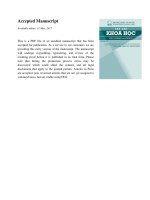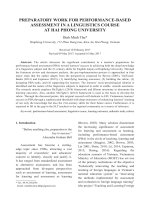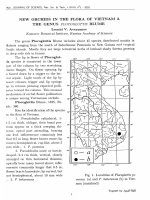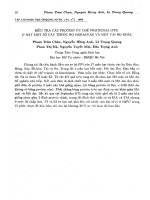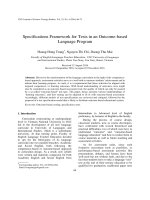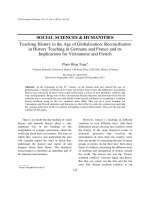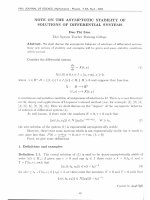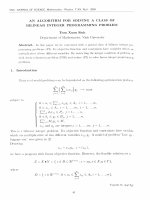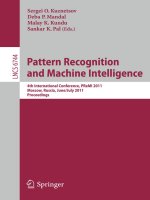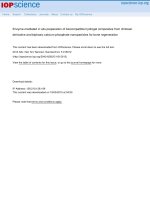DSpace at VNU: New criteria for exponential stability of nonlinear time-varying differential systems
Bạn đang xem bản rút gọn của tài liệu. Xem và tải ngay bản đầy đủ của tài liệu tại đây (123.08 KB, 12 trang )
INTERNATIONAL JOURNAL OF ROBUST AND NONLINEAR CONTROL
Int. J. Robust. Nonlinear Control (2012)
Published online in Wiley Online Library (wileyonlinelibrary.com). DOI: 10.1002/rnc.2885
New criteria for exponential stability of nonlinear time-varying
differential systems
Pham Huu Anh Ngoc* ,†
International University, Vietnam National University-HCMC, Thu Duc, Ho Chi Minh City, Vietnam
SUMMARY
General nonlinear time-varying differential systems are considered. An explicit criterion for exponential
stability is presented. Furthermore, an explicit robust stability bound for systems subjected to nonlinear
time-varying perturbations is given. In particular, it is shown that the generalized Aizerman conjecture holds
for positive linear systems. Some examples are given to illustrate obtained results. Copyright © 2012 John
Wiley & Sons, Ltd.
Received 25 April 2012; Revised 2 July 2012; Accepted 10 July 2012
KEY WORDS:
nonlinear differential system; time-varying; exponential stability; perturbation
1. INTRODUCTION AND PRELIMINARIES
Stability analysis of time-varying differential systems is always a central issue of control theory of
dynamical systems. Problems of stability and robust stability of time-varying differential systems
have attracted much attention from researchers and have been studied intensively during the past
decades (see, e.g. [1–20] and references therein). In this paper, we investigate exponential stability
of general nonlinear time-varying differential systems of the form
x.t
P / D f .t , x.t //,
t>
> 0.
(1)
Stability analysis of the nonlinear time-varying differential system (1) is, in general, hard. Several
approaches have been proposed in the literature, and most of them are based on the classical
Lyapunov method and its variants (see, e.g. [1, 2, 10–15]). In the present paper, we propose a new
approach to problems of stability and robust stability of the nonlinear time-varying differential
system (1). Our approach is based on the celebrated Perron–Frobenius theorem and ideas of the
comparison principle. We first present a new explicit criterion for exponential stability of the nonlinear time-varying differential system (1). Then, we give an explicit robust stability bound for
(1) subjected to nonlinear time-varying perturbations. In particular, we show that the generalized
Aizerman conjecture holds for positive linear systems.
Let N be the set of all natural numbers. For given m 2 N, let us denote m WD ¹1, 2, : : : , mº. Let
K D C or R where C and R denote the sets of all complex and all real numbers, respectively. For
integers l, q > 1, Kl denotes the l-dimensional vector space over K, and Kl q stands for the set of
all l q-matrices with entries in K. Inequalities between real matrices or vectors will be understood
componentwise; that is, for two real matrices A D .aij / and B D .bij / in Rł q , we write A > B if
aij > bij for i D 1,
, l, j D 1,
, q. In particular, if aij > bij for i D 1,
, l, j D 1,
, q,
then we write A
B instead of A > B. We denote by RlC q the set of all nonnegative matrices
*Correspondence to: Pham Huu Anh Ngoc, International University, Vietnam National University-HCMC, Thu Duc,
Ho Chi Minh City, Vietnam.
† E-mail:
Copyright © 2012 John Wiley & Sons, Ltd.
P. H. A. NGOC
A > 0. Similar notations are adopted for vectors. For x 2 Kn and P 2 Kl q , we define jxj D .jxi j/
and jP j D jpij j . A norm k k on Kn is said to be monotonic if kxk 6 kyk whenever x,
1
y 2 Kn , jxj 6 jyj. Every p-norm on Kn (kxkp D .jx1 jp C jx2 jp C C jxn jp / p , 1 6 p < 1
and kxk1 D maxi D1,2,:::,n jxi j), is monotonic. Throughout the paper, if otherwise not stated, the
norm of vectors on Kn is monotonic, and the norm of a matrix P 2 Kl q is understood as its
operator norm associated with a given pair of monotonic vector norms on Kl and Kq , that is
kP k D max¹kP yk W kyk D 1º. Note that
P 2 Kl
q
, Q 2 RlC q , jP j 6 Q )
kP k 6 k jP j k 6 kQk,
(2)
see, e.g. [21]. In particular, if Kn is endowed with k k1 or k k1 , then kAk D kjAjk for any
A D .aij / 2 Kn n . More precisely, one has
kAk1 D kjAjk1 D max
16j 6n
n
X
jaij jI
kAk1 D kjAjk1 D max
16i 6n
i D1
n
X
jaij j.
j D1
Let Br WD ¹x 2 Rn W kxk 6 rº for given r > 0. For any matrix M 2 C n n , the spectral abscissa of
M is denoted by .M / D max¹< W 2 .M /º, where .M / WD ¹´ 2 C W det.´In M / D 0º is
the spectrum of M . A matrix A 2 Rn n is called Hurwitz stable if .A/ < 0.
A matrix M 2 Rn n is called a Metzler matrix if all off-diagonal elements of M are nonnegative.
We now summarize in the following theorem some properties of Metzler matrices.
Theorem 1.1 ([21])
Suppose that M 2 Rn
n
is a Metzler matrix. Then
(i) (Perron–Frobenius) .M / is an eigenvalue of M , and there exists a nonnegative eigenvector
x Ô 0 such that M x D .M /x.
(ii) Given ˛ 2 R, there exists a nonzero vector x > 0 such that M x > ˛x if and only if
.M / > ˛.
(iii) .tIn M / 1 exists and is nonnegative if and only if t > .M /.
(iv) Given B 2 RnC n , C 2 C n n . Then
jC j 6 B
H)
.M C C / 6 .M C B/.
The following is immediate from Theorem 1.1 and is used in what follows.
Theorem 1.2
Let M 2 Rn
(i)
(ii)
(iii)
(iv)
(v)
n
be a Metzler matrix. Then the following statements are equivalent
.M / < 0;
0I
Mp
0 for some p 2 Rn , p
M is invertible and M 1 6 0;
For given b 2 Rn , b
0, there exists x 2 RnC , such that M x C b D 0.
n
For any x 2 RC n ¹0º, the row vector x T M has at least one negative entry.
2. CRITERIA FOR EXPONENTIAL STABILITY
Consider a nonlinear time-varying differential system of the form (1), where f W RC Rn ! Rn is
continuous and is locally Lipschitz in the second argument, uniformly in t on compact intervals of
RC and f .t , 0/ D 0, for all t 2 RC .
It is well known that for a fixed > 0 and a given x0 2 Rn , there exists a unique local solution
of (1) satisfying the initial condition
x. / D x0 .
Copyright © 2012 John Wiley & Sons, Ltd.
(3)
Int. J. Robust. Nonlinear Control (2012)
DOI: 10.1002/rnc
STABILITY OF NONLINEAR TIME-VARYING SYSTEMS
This solution is continuously differentiable on Π, / for some > and satisfies (1) for every
t 2 Π, / (see, e.g. [6]). It is denoted by x. I , x0 /. Furthermore, if the interval Π, / is the
maximum interval of existence of x. I , x0 /, then x. I , x0 / is said to be noncontinuable. The
existence of a noncontinuable solution follows from Zorn’s lemma, and the maximum interval of
existence must be open.
Definition 2.1
The zero solution of (1) is said to be exponentially stable if there exist positive numbers r, K, ˇ such
that for each 2 RC and each x0 2 Br , the solution x. I , x0 / of (1) and (3) exists on Π, 1/ and
furthermore satisfies
kx.t I , x0 /k 6 Ke
ˇ .t
/
kx0 k, 8t > .
When the zero solution of (1) is exponentially stable, we also say that (1) is exponentially stable.
We are now in the position to state the main result of this note.
Theorem 2.2
Suppose that for each t 2 RC , f .t , / is continuously differentiable on Rn . Let
Â
Ã
@fi
J.t , x/ WD
.t , x/ 2 Rn n , t 2 RC , x 2 Rn ,
@xj
be the Jacobian matrix of f .t , / at x. Assume that there exists a Hurwitz stable Metzler matrix
A WD .aij / 2 Rn n such that for any t > 0 and any x 2 Rn ,
ˇ
ˇ
ˇ @fi
ˇ
@fi
ˇ
.t , x/ 6 ai i , i 2 nI ˇ
.t , x/ˇˇ 6 aij , i 6D j , i, j 2 n.
(4)
@xi
@xj
Then, (1) is exponentially stable.
Proof
Let x0 2 Rn be given and let x.t / WD x.t I , x0 /, t 2 Π, / be a noncontinuable solution of (1)
and (3). We first show that there exists ˇ > 0 such that for any > 0 and any r > 0 and any
x0 2 Br , we have
kx.t I , x0 /k 6 Ke
ˇ .t
/
, 8t 2 Π, /,
(5)
where K 2 R is independent of t , and x0 .
Because A is a Hurwitz stable Metzler matrix, there exists p WD .˛1 , ˛2 , : : : , ˛n /T , ˛i > 0, 8i 2 n
such that
Ap
0,
(6)
by (ii) of Theorem 1.2. Furthermore, (6) implies that
Ap
ˇp D ˇ.˛1 , : : : , ˛n /T ,
(7)
for some sufficiently small ˇ > 0. Fix r > 0 and choose K > 0 such that jx0 j
Kp for any
x0 2 Br . Define u.t / WD Ke ˇ .t / p, t 2 Œ , 1/. Set x.t / WD x.t I , x0 /, t 2 Œ , /. Note that
jx. /j D jx0 j u. / D Kp. We claim that jx.t /j 6 u.t / for any t 2 Π, /.
Assume on the contrary that there exists t0 > such that jx.t0 /j 66 u.t0 /. Set t1 WD inf¹t 2 . , / W
jx.t /j 66 u.t /º. By continuity, t1 > , and there is i0 2 n such that
jx.t /j 6 u.t /, 8t 2 Π, t1 /I jxi0 .t1 /j D ui0 .t1 /, jxi0 .t /j > ui0 .t /, 8t 2 .t1 , t1 C /,
(8)
for some > 0. By the mean value theorem [22], we have for each t 2 R and for each i 2 n
Ã
n ÂZ 1
X
@fi
xP i .t / D fi .t , x.t // D .fi .t , x/ fi .t , 0// D
.t , sx.t //ds xj .t /.
0 @xj
j D1
Copyright © 2012 John Wiley & Sons, Ltd.
Int. J. Robust. Nonlinear Control (2012)
DOI: 10.1002/rnc
P. H. A. NGOC
Thus,
Ã
n ÂZ 1
X
d
@fi
.t , sx.t //ds xj .t /
jxi .t /j D sgn.xi .t //xP i .t / D sgn.xi .t //
dt
0 @xj
j D1
ÂZ 1
Ã
Ã
ÂZ 1
n
X
@fi
@fi
.t , sx.t //ds jxi .t /j C sgn.xi .t //
.t , sx.t //ds xj .t /
D
0 @xi
0 @xj
j D1,j 6Di
for almost any t 2 Π, /. Then, (4) implies
d
jxi .t /j 6 ai i jxi .t /j C
dt
n
X
aij jxj .t /j,
(9)
j D1,j 6Di
for almost any t 2 Π, /. It follows that for any t 2 Π, /
D C jxi .t /j WD lim sup
h!0C
jxi .t C h/j
h
jxi .t /j
h!0C
n
X
6 ai i jxi .t /j C
D lim sup
1
h
Z
t
t Ch
d
jxi .s/jds
ds
aij jxj .t /j,
j D1,j 6Di
where D C denotes the Dini upper-right derivative. In particular, it follows from (7) and (8) that
.8/
D C jxi0 .t1 /j 6 ai0 i0 Ke
ˇ .t1
/
n
X
˛i0 C
ai0 j Ke
ˇ .t1
/
˛j D Ke
ˇ .t1
/
< K. ˇ/e
ˇ .t1
/
ai0 j ˛j
j D1
j D1,j 6Di0
.7/
n
X
˛i0 D D C ui0 .t1 /.
However, this conflicts with (8). Hence,
jx.t I , x0 /j 6 u.t / D Ke
ˇ .t
/
p, 8 > 0I 8x0 2 Br I 8t 2 Π, /.
By the monotonicity of vector norms, this yields
kx.t I , x0 /k 6 K1 e
ˇ .t
/
, 8 > 0I 8x0 2 Br I 8t 2 Π, /,
for some K1 > 0.
Finally, we show that D 1, and so (1) is exponentially stable. Seeking a contradiction, we
assume that < 1. Then it follows from (5) that x. I , x0 / is bounded on Π, /. Furthermore,
this together with (1) implies that x.
P / is bounded on Π, /. Thus, x. / is uniformly continuous
on Π, /. Therefore, limt ! x.t / exists, and x. / can be extended to a continuous function on
Π, . Then, one can find a solution of (1) through . , x. // to the right of . This contradicts the
noncontinuability hypothesis on x. /. Thus, must be equal to 1, and this completes the proof.
The following is immediate from Theorem 2.2.
Corollary 2.3
Suppose f W Rn ! Rn is continuously differentiable. Then, the system
x.t
P / D f .x.t //,
t>
> 0,
is exponentially stable provided that there exists a Hurwitz stable Metzler matrix A WD .aij / 2 Rn
such that for any x 2 Rn ,
ˇ
ˇ
ˇ @fi
ˇ
@fi
ˇ
.x/ 6 ai i , i 2 nI ˇ
.x/ˇˇ 6 aij , i 6D j , i, j 2 n.
@xi
@xj
Copyright © 2012 John Wiley & Sons, Ltd.
n
Int. J. Robust. Nonlinear Control (2012)
DOI: 10.1002/rnc
STABILITY OF NONLINEAR TIME-VARYING SYSTEMS
To state the next result, we now consider a linear time-varying differential system of the form
x.t
P / D A.t /x.t /,
where A. / W RC ! Rn
n
t>
> 0,
(10)
, k 2 m is a given continuous vector function.
Corollary 2.4
Let A.t / WD .aij .t //, t > 0. Suppose there exists a Hurwitz stable Metzler matrix A WD .aij / 2 Rn
so that for any t > 0
ai i .t / 6 ai i , i 2 nI
n
jaij .t /j 6 aij , 8i 6D j , i, j 2 n.
Then, (10) is exponentially stable.
We illustrate the obtained results by a couple of examples.
Example 2.5
Consider the nonlinear time-varying differential equation
Â
Ã
3
2t
x.t
P /D
x.t / C sin 2
x.t / ,
2
t C1
t>
> 0.
(11)
Á
.t , x/ D
Clearly, (11) is of the form (1) with f .t , x/ WD 32 x Csin t 22tC1 x . Furthermore, f and @f
@x
Á
3
C t 22tC1 cos t 22tC1 x are continuous on RC R. Because @f
.t , x/ 6 12 , 8t > 0, 8x 2 R, (11) is
2
@x
exponentially stable, by Theorem 2.2.
Example 2.6
Consider the nonlinear time-varying differential system
8
x1 .t /
t2
ˆ
< xP 1 .t / D 4e x1 .t / C 1Cx 2 .t / sin x2 .t /
1
Á
ˆ
2
1 .t /
:
xP 2 .t / D sin 2tx
2e t x2 .t /
t 2 C1
(12)
where t > > 0.
Then, (12) can be represented in the form (1) with
0
1
2
x1
4e t x1 C 1Cx
2 sin x2
B
C
1
T
2
f W RC R2 ! R2 I f .t , x/ D .t , x/ 7! @
Á
A , x D .x1 , x2 / 2 R .
2tx1
t2
sin t 2 C1
2e x2 ,
(13)
It is clear that f is continuous on RC R2 and f .t , / is continuously differentiable on R2 for each
t 2 RC and f .t , 0/ D 0, 8t 2 RC . Furthermore, the Jacobian matrix of f .t , / is given by
0
B
J.t , x/ D @
1 x12
2
4e t C
2t
t 2 C1
.
2
1Cx12
cos
/
sin x2
2tx1
t 2 C1
Á
x1
x12 C1
cos x2
2e
t2
1
C
A,
t > 0, x D .x1 , x2 /T 2 R2 .
1 Ã
3
2
is Hurwitz stable and satisfies (4) with n D 2.
1
2
Thus, (12) is exponentially stable, by Theorem 2.2.
Â
It is easy to check that the matrix A WD
Copyright © 2012 John Wiley & Sons, Ltd.
Int. J. Robust. Nonlinear Control (2012)
DOI: 10.1002/rnc
P. H. A. NGOC
3. STABILITY OF PERTURBED SYSTEMS
Suppose all hypotheses of Theorem 2.2 hold. Thus, (1) is exponentially stable. Consider a perturbed
system of the form
x.t
P / D f .t , x.t // C
N
X
Dk .t , x.t //Pk .t , Ek .t , x.t /// ,
t>
> 0,
(14)
kD1
where N is a given positive integer and Dk W RC Rn ! Rn lk , Ek W RC Rn ! Rqk , (k 2 N ) are
given continuous functions and Pk W RC Rqk ! Rlk (k 2 N ) are unknown continuous functions.
Furthermore, we assume that
(H1 ) for each k 2 N , Dk , Pk and Ek (k 2 N ) are locally Lipschitz in the second argument
uniformly in t on compact intervals of RC and Pk .t , 0/ D 0, Ek .t , 0/ D 0 for all t 2 RC ;
n l
q n
l q
(H2 ) there exist Dk 2 RC k , Ek 2 RCk and Pk 2 RCk k (k 2 N ) such that
8t 2 RC , x 2 Rn
(15)
jPk .t , y/j 6 Pk jyj,
8t 2 RC , 8y 2 Rqk . (16)
jDk .t , x/j 6 Dk ,
and
jEk .t , x/j 6 Ek jxj,
8t 2 RC , 8x 2 Rn I
Note that the preceding assumptions imply that the right hand side of (14) is continuous on RC Rn
and is locally Lipschitz in the second argument. Thus, (14) always has a unique local solution
satisfying the initial condition (3).
The main problem here is to find a positive number such that an arbitrary perturbed system of
the form (14) remains exponentially stable whenever the size of perturbations is less than .
Remark 3.1
In particular, if
Ek .t , x/ WD Ek .t /xI Pk .t , y/ WD Pk .t /y, t > 0I x 2 Rn I y 2 Rqk ,
P
PN
then perturbation term N
kD1 Dk .t , x.t //Pk .t , Ek .t , x.t /// becomes
kD1 Dk .t /Pk .t /Ek .t /x.t /.
The robust stability of linear time-varying system (10) under the time-varying multi-perturbations
Dk .t , x/ WD Dk .t /I
A.t / ,! A.t / C
N
X
Dk .t /Pk .t /Ek .t /,
(17)
kD1
has been analyzed in [7], and an abstract stability bound was given in terms of input–output
operators.
Theorem 3.2
Assume that all hypotheses of Theorem 2.2 hold and A 2 Rn
hold and
N
X
kPk k <
kD1
1
maxi ,j 2N kEi A
n
is as in Theorem 2.2. If (H1 )–.H2 )
1D
jk
,
(18)
then (14) remains exponentially stable.
Proof
We divide the proof into two steps.
Step 1
We claim that
AC
PN
kD1
Á
Dk Pk Ek < 0.
Copyright © 2012 John Wiley & Sons, Ltd.
Int. J. Robust. Nonlinear Control (2012)
DOI: 10.1002/rnc
STABILITY OF NONLINEAR TIME-VARYING SYSTEMS
N
P
Because A is a Metzler matrix and Dk , Ek , Pk are nonnegative for any k 2 N , A C
Dk Pk Ek
kD1
!
N
P
is a Metzler matrix. We show that 0 WD
AC
Dk Pk Ek < 0. Assume on the contrary that
kD1
0
> 0. By the Perron–Frobenius theorem (Theorem 1.1 (i)), there exists x 2 RnC , x 6D 0 such that
N
X
AC
!
Dk Pk Ek x D
0 x.
kD1
Let Q.t / D tIn
A, t 2 R. Because .A/ < 0, Q.
0/
Q.
1
N
X
0/
is invertible. It follows that
Dk Pk Ek x D x.
(19)
kD1
Let i0 be an index such that kEi0 xk D maxk2N kEk xk. It follows from (19) that kEi0 xk > 0.
Multiply both sides of (19) from the left by Ei0 to obtain
N
X
Ei0 Q.
0/
1
Dk Pk Ek x D Ei0 x.
kD1
It follows that
N
X
kEi0 Q.
1
0/
Dk kkPk kkEk xk > kEi0 xk.
kD1
Thus,
max kEi Q.
0/
i ,j 2N
1
N
X
Dj k
!
kPk k kEi0 xk > kEi0 xk,
kD1
or equivalently,
max kEi Q.
i ,j 2N
0/
1
Dj k
N
X
kPi k > 1.
(20)
kD1
On the other hand, the resolvent identity gives
Q.0/
1
Q.
0/
1
D
0 Q.0/
1
Q.
1
0/
.
(21)
Because A is a Metzler matrix with .A/ < 0 and 0 > 0, Theorem 1.1 (iii) yields Q.0/ 1 > 0
and Q. 0 / 1 > 0. Then, (21) implies that Q.0/ 1 > Q. 0 / 1 > 0. Hence, Ei Q.0/ 1 Dj >
Ei Q. 0 / 1 Dj > 0, for any i, j 2 N . By (2), kEi Q.0/ 1 Dj k > kEi Q. 0 / 1 Dj k, for any i,
j 2 N . Thus, (20) implies that
N
X
kPk k >
kD1
maxi ,j 2N
1
kEi Q.0/
1D
jk
.
However, this conflicts with (18).
Copyright © 2012 John Wiley & Sons, Ltd.
Int. J. Robust. Nonlinear Control (2012)
DOI: 10.1002/rnc
P. H. A. NGOC
Step 2
The proof of Step 2 is similar to that of Theorem 2.2.
Let x0 2 Rn be given, and let x.t / WD x.t I , x0 /, t 2 Π, / be a noncontinuable solution of (14)
satisfying the initial condition (3).
We first show that there exists ˇ > 0 such that for any > 0 and any r > 0 and any x0 2 Br ,
we have
kx.t I , x0 /k 6 Ke
ˇ .t
/
, 8t 2 Π, /,
(22)
where K is independent of t , , x0 .
By (ii) of Theorem 1.2, there exists p WD .˛1 , ˛2 , : : : , ˛n /T , ˛i > 0, 8i 2 n such that
!
N
X
Dk Pk Ek p
0.
AC
(23)
kD1
Furthermore, (23) implies that
AC
N
X
!
Dk Pk Ek p
ˇp D ˇ.˛1 , : : : , ˛n /T ,
(24)
kD1
for some sufficiently small ˇ > 0. Fix r > 0 and choose K > 0 such that jx0 j
Kp for any
x0 2 Br . Define u.t / WD Ke ˇ .t / p, t 2 Œ , 1/. Set x.t / WD x.t I , x0 /, t 2 Œ , /. Note that
jx. /j D jx0 j u. / D Kp. We show that jx.t /j 6 u.t / for any t 2 Π, /.
P
n n
. Taking (15)–(16) into account, we obtain the following
Let N
kD1 Dk Pk Ek WD .bij / 2 R
estimate
n
n
X
X
d
jaij jjxj .t /j C
bij jxj .t /j,
(25)
jxi .t /j 6 ai i jxi .t /j C
dt
j D1
j D1,j 6Di
for almost any t 2 Π, /. The remainder of the proof is similar to that of the proof of
Theorem 2.2.
Suppose all hypotheses of Corollary 2.4 hold. Thus, (10) is exponentially stable. Consider a
perturbed system of the form
x.t
P / D A.t /x.t / C
N
X
Dk .t , x.t //Pk .t , Ek .t , x.t /// ,
t>
> 0,
(26)
kD1
where Dk , Pk and Ek , (k 2 N ) are as previously.
The following is immediate from Theorem 3.2.
Corollary 3.3
Let A 2 Rn n be as in Corollary 2.4. Suppose .H1 )–.H2 ) hold. If (18) holds, then (26) is
exponentially stable.
Corollary 3.4
Let A 2 Rn n be a Hurwitz stable Metzler matrix. Suppose Dk W RC ! Rn lk , Ek W RC ! Rqk n
.k 2 N / are given continuous functions and Pk W RC ! Rlk qk is an unknown continuous function.
n l
q n
l q
If there exist Dk 2 RC k , Ek 2 RCk and Pk 2 RCk k .k 2 N / such that
jDk .t /j 6 Dk I jEk .t /j 6 Ek I jPk .t /j 6 Pk ,
and (18) holds, then the perturbed system
x.t
P /D AC
N
X
8t > 0,
!
Dk .t /Pk .t /Ek .t / x.t /,
t>
> 0,
(27)
kD1
is exponentially stable.
Copyright © 2012 John Wiley & Sons, Ltd.
Int. J. Robust. Nonlinear Control (2012)
DOI: 10.1002/rnc
STABILITY OF NONLINEAR TIME-VARYING SYSTEMS
Remark 3.5
When A 2 Rn
n
is a Metzler matrix, the system
x.t
P / D Ax.t /,
t > 0,
(28)
is positive. That is, for any initial state x0 2 RnC , the corresponding trajectory of the system
x.t , x0 / remains in RnC for all t > 0. Positive dynamical systems play an important role in
modeling of dynamical phenomena whose variables are restricted to be nonnegative. They are often
encountered in applications, for example, networks of reservoirs, industrial processes involving
chemical reactors, heat exchangers, distillation columns, storage systems, hierarchical systems,
compartmental systems used for modeling transport and accumulation phenomena of substances
(see, e.g. [5, 23]).
In particular, the problem of robust stability of the positive linear differential system (28) under
the time-invariant structured perturbations
A ,! A C DE
has been studied in [9, 21, 24]. For example, it has been shown in [9, Theorem 5] that if (28) is
exponentially stable and positive and D, E are given nonnegative matrices, then a perturbed system
of the form
x.t
P / D .A C DE/x.t /,
t > 0,
remains exponentially stable whenever
kk <
1
.
kEA 1 Dk
This result has been extended to various classes of positive differential systems such as positive
linear time-delay differential systems, positive linear functional differential systems, positive linear
Volterra integro-differential systems, and so on (see, e.g. [25–31]). Furthermore, the problem of
robust stability of the positive system (28) under the time-invariant multi-perturbations
A ,! A C
N
X
Di i Ei ,
i D1
has been analyzed in [9] by techniques of -analysis.
Although there are many works devoted to the study of robust stability of differential systems,
to the best of our knowledge, the problem of robust stability of the positive system (28) under the
time-varying multi-perturbations
A ,! A C
N
X
Dk .t /Pk .t /Ek .t /,
kD1
has not yet been studied, and a result like Corollary 3.4 cannot be found in the literature.
We illustrate the obtained results by a couple of examples.
Example 3.6
We now reconsider (11). As shown in Example 2.5, (11) is exponentially stable. Consider a
perturbed equation given by
Â
Ã
Â
Ã
3
2t
t2
x.t
P /D
x.t / C sin 2
C be
x.t / C sin.ax.t //,
t > > 0.
(29)
2
t C1
where a, b 2 R are parameters.
Copyright © 2012 John Wiley & Sons, Ltd.
Int. J. Robust. Nonlinear Control (2012)
DOI: 10.1002/rnc
P. H. A. NGOC
2
Note that jbe t xj 6 jbjjxj and j sin.ax/j 6 jajjxj, for all t > 0, x 2 R. Thus, by Theorem (3.2),
(29) is exponentially stable if jaj C jbj 6 12 .
Example 3.7
Consider a linear differential equation in R2 defined by
x.t
P / D Ax.t /,
t > 0,
(30)
where
Â
1
1
A WD
1
2
Ã
.
Clearly, (30) is positive and exponentially stable. Consider a perturbed system given by
x.t
P / D .A C D1 .t /P1 .t /E1 .t / C D2 .t /P2 .t /E2 .t // x.t /,
(31)
where
Â
D1 .t / WD
E1 .t / WD
e
sin t
1
t2
Ã
Â
,
Ã
0
1
cos2 t C1
!
0
2t
t 2 C1
1
t > 0I D2 .t / WD
,
1
1Ct 2
t > 0I E2 .t / WD
,
t > 0I
0
!
,
1
t C1
0
t > 0,
and P1 .t / WD .a.t /, b.t // 2 R1 2 , t > 0 and P2 .t / WD .c.t /, d.t // 2 R1 2 , t > 0 are unknown.
Note that for any t > 0, we have
 Ã
 Ã
1
0
jD1 .t /j 6 D1 WD
I jD2 .t /j 6 D2 WD
I
1
1
Â
jE1 .t /j 6 E1 WD
1 0
1 1
Ã
Â
I jE2 .t /j 6 E2 WD
1 0
0 1
Ã
and
Â
E1 A
1
D1 D
E1 A
1
D2 D
E2 A
1
D1 D
E2 A
1
Â
Â
Â
D2 D
1 0
1 1
1 0
1 1
1 0
0 1
1 0
0 1
ÃÂ
ÃÂ
ÃÂ
ÃÂ
2
1
1
1
2
1
1
1
2
1
1
1
2
1
1
1
ÃÂ
ÃÂ
ÃÂ
ÃÂ
1
1
0
1
1
1
0
1
Ã
Â
D
Ã
Â
D
Ã
Â
D
Ã
Â
D
3
5
1
2
3
2
1
1
Ã
I
Ã
I
Ã
I
Ã
.
Let R2 be endowed with 2-norm. By Corollary 3.4, (31) is exponentially stable if a. /, b. /, c. /, d. /
are continuous, bounded and satisfy
r
r
1
. sup ja.t /j/2 C . sup jb.t /j/2 C . sup jc.t /j/2 C . sup jd.t /j/2 < p .
34
t 2RC
t 2RC
t 2RC
t 2RC
Copyright © 2012 John Wiley & Sons, Ltd.
Int. J. Robust. Nonlinear Control (2012)
DOI: 10.1002/rnc
STABILITY OF NONLINEAR TIME-VARYING SYSTEMS
4. GENERALIZED AIZERMAN CONJECTURE
As an application, we now deal with an extension of the classical Aizerman conjecture.
Generalized Aizerman conjecture: Let A 2 Rn n , D 2 Rn l , E 2 Rq n be given. For any
the linear systems
x.t
P / D .A C DE/x.t /,
2 Rl
q
>0
kk < ,
,
(32)
are asymptotically stable if and only if the origin is globally asymptotically stable for all nonlinear
systems
x.t
P / D Ax.t / C DN .t , Ex.t //,
(33)
where N W RC Rq ! Rl , N .t , 0/ D 0, 8t > 0 is continuous and is locally Lipschitz in the second
argument, uniformly in t on any compact interval of RC and satisfies
jN .t , y/j 6 P jyj, 8t > 0, 8y 2 Rq
and P 2 Rl
q
, kP k < .
(34)
In particular, when N W R ! R, y 7! N .y/ is a scalar function and D, E 2 R , the
generalized Aizerman conjecture reduces to an equivalent form of the classical Aizerman conjecture
(see, e.g. [8, page 702]). The original Aizerman conjecture is stated first in [3]. It is well known that
in general, the Aizerman’s conjecture does not hold (see, e.g. [32]). So a natural question is that
under what conditions of A, D, E and N does the Aizerman’s conjecture hold?
T
n
Theorem 4.1
If A 2 Rn n is a Metzler matrix and D 2 RnC l , E 2 RqC n , then the generalized Aizerman
conjecture holds.
In other words, if D 2 RnC l , E 2 RqC n , then the generalized Aizerman conjecture holds for
linear positive time-varying differential systems.
Proof
Suppose (32) is asymptotically stable for any 2 Rl q , kk < , for some > 0. In particular, the
unperturbed system x.t
P / D Ax.t / is asymptotically stable. It follows from Corollary 3.4 that (32)
is asymptotically stable for any 2 Rl q , kk < kEA1 1 Dk (see also Remark 3.5). Furthermore,
there exists 0 2 RlC q , k0 k D kEA1 1 Dk such that (32) is not asymptotically stable for WD 0
(see, e.g. [9]). It remains to show that (33) is globally asymptotically stable for any nonlinearity N
satisfying (34) with WD kEA1 1 Dk .
Let N satisfy (34) with WD kEA1 1 Dk . Because P 2 Rl q , kP k < kEA1 1 Dk , (33) is globally
asymptotically stable, by Corollary 3.3.
Conversely, assume that (33) is globally asymptotically stable for any nonlinearity N satisfying
(34) for some > 0. Then, the unperturbed system x.t
P / D Ax.t / is asymptotically stable. As
mentioned earlier, (32) is asymptotically stable for any 2 Rl q , kk < kEA1 1 Dk . So we assume
that
>
1
kEA
1 Dk
. Note that (32) is not asymptotically stable for some 0 2 RlC q , k0 k D
1 Dk . This means that (33) is not globally asymptotically stable for N defined by N .t , y/ WD
0 y, t > 0, y 2 Rq . This completes the proof.
1
kEA
REFERENCES
1. Aeyels D, Peuteman J. A new asymptotic stability criterion for nonlinear time-variant differential equations. IEEE
Transactions on Automatic Control 1998; 43:968–971.
2. Aeyels D, Peuteman J. On exponential stability of nonlinear time-varying differential equations. Automatica 1999;
35:1091–1100.
3. Aizerman MA. On one problem concerning the stability in “Large” of Dynamic Systems. Uspekhi Matematicheskikh
Nauk 1949; 4:186–188.
4. Amato R, Celentano G, Garofalo F. New sufficient conditions for the stability of slowly varying linear systems. IEEE
Transactions on Automatic Control 1993; 38:1409–1411.
Copyright © 2012 John Wiley & Sons, Ltd.
Int. J. Robust. Nonlinear Control (2012)
DOI: 10.1002/rnc
P. H. A. NGOC
5. Haddad WM, Chellaboina V, Hui Q. Nonnegative and Compartmental Dynamical Systems. Princeton University
Press: New York, 2010.
6. Hartman P. Ordinary Differential Equations, Second Edition. SIAM Society for Industrial and Applied Mathematics:
Philadelphia, 2002.
7. Hinrichsen D, Pritchard A. Robust exponential stability of time-varying linear systems under time-varying parameter
perturbations. International Journal of Robust and Nonlinear Control 1993; 3:63–83.
8. Hinrichsen D, Pritchard AJ. Mathematical Systems Theory I. Springer-Verlag: Berlin-Heidelberg, 2005.
9. Hinrichsen D, Son NK. -analysis and robust stability of positive linear systems. International Journal of Applied
Mathematics and Computer Science 1998; 8:253–268.
10. Kato J, Martynyuk AA, Shestakov AA. Stability of Motion of Nonautonomous Systems (Method of Limiting
Equations). Gordon and Breach: Amsterdam, 1996.
11. Linh NM, Phat VN. Exponential stability of nonlinear time-varying differential equations and applications.
Electronic Journal of Differential Equations 2001; 2001(34):1–13.
12. Mazenc F. Strict Lyapunov functions for time-varying systems. Automatica 2003; 39:349–353.
13. Mazenc F, Malisoff M, Lin Z. Further results on input-to-state stability for nonlinear systems with delayed feedbacks.
Automatica 2008; 44:2415–2421.
14. Peuteman J, Aeyels D. Averaging results and the study of uniform asymptotic stability of homogeneous differential
equations that are not fast time-varying. SIAM Journal on Control and Optimization 1999; 37:997–1010.
15. Peuteman J, Aeyels D. Exponential stability of nonlinear time-varying differential equations and partial averaging.
Mathematics of Control, Signals, and Systems 2002; 15:42–70.
16. Phat VN. On the stability of time-varying differential equations. Optimization 1999; 45:237–254.
17. Phat VN, Niamsup P. Stability analysis for a class of functional differential equations and applications. Nonlinear
Analysis: Theory Methods and Applications 2009; 71:6265–6275.
18. Solo V. On the stability of slowly time-varying linear systems. Mathematics of Control, Signals, and Systems 1994;
7:331–350.
19. Wu MY. Stability of linear time-varying systems. International Journal of Systems Science 1984; 15:1799–1804.
20. Zevin A. Exponential stability and solution bounds for systems with bounded nonlinearities. IEEE Transactions on
Automatic Control 2003; 48:1799–1804.
21. Son NK, Hinrichsen D. Robust stability of positive continuous-time systems. Numerical Functional Analysis and
Optimization 1996; 17:649–659.
22. Dieudonne J. Foundations of Modern Analysis. Academic Press: New York, 1988.
23. Farina L, Rinaldi S. Positive Linear Systems: Theory and Applications. John Wiley and Sons: New York, 2000.
24. Shafai B, Chen J, Kothandaraman M. Explicit formulas for stability radii of nonnegative and Metzlerian matrices.
IEEE Transactions on Automatic Control 1997; 42:265–270.
25. Naito T, Shin JS, Murakami S, Ngoc PHA. Characterizations of positive linear Volterra integro-differential systems.
Integral Equations and Operator Theory 2007; 58:255–272.
26. Ngoc PHA. Stability radii of positive linear Volterra-Stieltjes equations. Journal of Differential Equations 2007;
243:101–122.
27. Ngoc PHA. On positivity and stability of linear Volterra systems with delay. SIAM Journal on Control and
Optimization 2009; 48:1939–1960.
28. Ngoc PHA. Stability of linear Volterra-Stieltjes differential equations. SIAM Journal on Control and Optimization
2011; 49:205–226.
29. Ngoc PHA, Naito T, Shin JS, Murakami S. On stability and robust stability of positive linear Volterra equations.
SIAM Journal on Control and Optimization 2008; 47:975–996.
30. Ngoc PHA, Son NK. Stability radii of linear systems under multi-perturbations. Numerical Functional Analysis and
Optimization 2004; 25(2):221–238.
31. Ngoc PHA, Son NK. Stability radii of positive linear functional differential equations under multi-perturbations.
SIAM Journal on Control and Optimization 2005; 43:2278–2295.
32. Fitts RE. Two counterexamples to Aizerman’s conjecture. IEEE Transactions on Automatic Control 1966;
11:553–556.
Copyright © 2012 John Wiley & Sons, Ltd.
Int. J. Robust. Nonlinear Control (2012)
DOI: 10.1002/rnc
